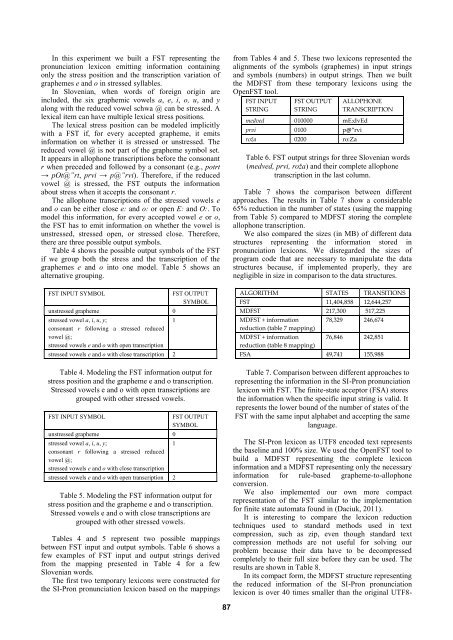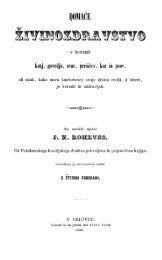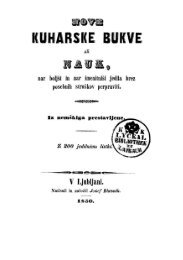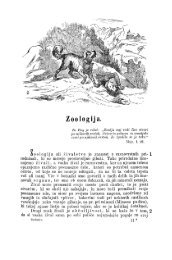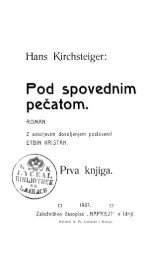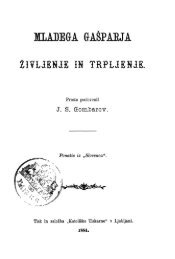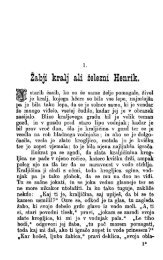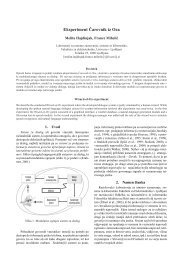Proceedings - Natural Language Server - IJS
Proceedings - Natural Language Server - IJS
Proceedings - Natural Language Server - IJS
Create successful ePaper yourself
Turn your PDF publications into a flip-book with our unique Google optimized e-Paper software.
In this experiment we built a FST representing the<br />
pronunciation lexicon emitting information containing<br />
only the stress position and the transcription variation of<br />
graphemes e and o in stressed syllables.<br />
In Slovenian, when words of foreign origin are<br />
included, the six graphemic vowels a, e, i, o, u, and y<br />
along with the reduced vowel schwa @ can be stressed. A<br />
lexical item can have multiple lexical stress positions.<br />
The lexical stress position can be modeled implicitly<br />
with a FST if, for every accepted grapheme, it emits<br />
information on whether it is stressed or unstressed. The<br />
reduced vowel @ is not part of the grapheme symbol set.<br />
It appears in allophone transcriptions before the consonant<br />
r when preceded and followed by a consonant (e.g., potrt<br />
→ pOt@”rt, prvi → p@”rvi). Therefore, if the reduced<br />
vowel @ is stressed, the FST outputs the information<br />
about stress when it accepts the consonant r.<br />
The allophone transcriptions of the stressed vowels e<br />
and o can be either close e: and o: or open E: and O:. To<br />
model this information, for every accepted vowel e or o,<br />
the FST has to emit information on whether the vowel is<br />
unstressed, stressed open, or stressed close. Therefore,<br />
there are three possible output symbols.<br />
Table 4 shows the possible output symbols of the FST<br />
if we group both the stress and the transcription of the<br />
graphemes e and o into one model. Table 5 shows an<br />
alternative grouping.<br />
FST INPUT SYMBOL FST OUTPUT<br />
SYMBOL<br />
unstressed grapheme 0<br />
stressed vowel a, i, u, y;<br />
consonant r following a stressed reduced<br />
vowel @;<br />
stressed vowels e and o with open transcription<br />
stressed vowels e and o with close transcription 2<br />
Table 4. Modeling the FST information output for<br />
stress position and the grapheme e and o transcription.<br />
Stressed vowels e and o with open transcriptions are<br />
grouped with other stressed vowels.<br />
FST INPUT SYMBOL FST OUTPUT<br />
SYMBOL<br />
unstressed grapheme 0<br />
stressed vowel a, i, u, y;<br />
consonant r following a stressed reduced<br />
vowel @;<br />
stressed vowels e and o with close transcription<br />
stressed vowels e and o with open transcription 2<br />
Table 5. Modeling the FST information output for<br />
stress position and the grapheme e and o transcription.<br />
Stressed vowels e and o with close transcriptions are<br />
grouped with other stressed vowels.<br />
Tables 4 and 5 represent two possible mappings<br />
between FST input and output symbols. Table 6 shows a<br />
few examples of FST input and output strings derived<br />
from the mapping presented in Table 4 for a few<br />
Slovenian words.<br />
The first two temporary lexicons were constructed for<br />
the SI-Pron pronunciation lexicon based on the mappings<br />
1<br />
1<br />
87<br />
from Tables 4 and 5. These two lexicons represented the<br />
alignments of the symbols (graphemes) in input strings<br />
and symbols (numbers) in output strings. Then we built<br />
the MDFST from these temporary lexicons using the<br />
OpenFST tool.<br />
FST INPUT<br />
STRING<br />
FST OUTPUT<br />
STRING<br />
ALLOPHONE<br />
TRANSCRIPTION<br />
medved 010000 mE:dvEd<br />
prvi 0100 p@”rvi<br />
roža 0200 ro:Za<br />
Table 6. FST output strings for three Slovenian words<br />
(medved, prvi, roža) and their complete allophone<br />
transcription in the last column.<br />
Table 7 shows the comparison between different<br />
approaches. The results in Table 7 show a considerable<br />
65% reduction in the number of states (using the mapping<br />
from Table 5) compared to MDFST storing the complete<br />
allophone transcription.<br />
We also compared the sizes (in MB) of different data<br />
structures representing the information stored in<br />
pronunciation lexicons. We disregarded the sizes of<br />
program code that are necessary to manipulate the data<br />
structures because, if implemented properly, they are<br />
negligible in size in comparison to the data structures.<br />
ALGORITHM STATES TRANSITIONS<br />
FST 11,404,858 12,644,257<br />
MDFST 217,300 517,225<br />
MDFST + information<br />
reduction (table 7 mapping)<br />
MDFST + information<br />
reduction (table 8 mapping)<br />
78,329 246,674<br />
76,846 242,851<br />
FSA 49,741 155,988<br />
Table 7. Comparison between different approaches to<br />
representing the information in the SI-Pron pronunciation<br />
lexicon with FST. The finite-state acceptor (FSA) stores<br />
the information when the specific input string is valid. It<br />
represents the lower bound of the number of states of the<br />
FST with the same input alphabet and accepting the same<br />
language.<br />
The SI-Pron lexicon as UTF8 encoded text represents<br />
the baseline and 100% size. We used the OpenFST tool to<br />
build a MDFST representing the complete lexicon<br />
information and a MDFST representing only the necessary<br />
information for rule-based grapheme-to-allophone<br />
conversion.<br />
We also implemented our own more compact<br />
representation of the FST similar to the implementation<br />
for finite state automata found in (Daciuk, 2011).<br />
It is interesting to compare the lexicon reduction<br />
techniques used to standard methods used in text<br />
compression, such as zip, even though standard text<br />
compression methods are not useful for solving our<br />
problem because their data have to be decompressed<br />
completely to their full size before they can be used. The<br />
results are shown in Table 8.<br />
In its compact form, the MDFST structure representing<br />
the reduced information of the SI-Pron pronunciation<br />
lexicon is over 40 times smaller than the original UTF8-


